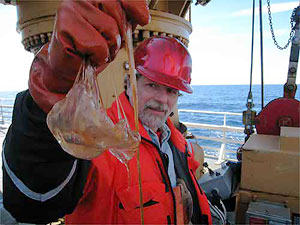

 | |||||||||||
|
|
Journals 2008/2009John Karavias
July 3, 2008 At approximately 1:15 p.m. the tugboat pushed the Healy away from the dock and we were on our way. Within three hours we were at our first station and the CTD was dropped. We were in 70 meters of water in the Unimak Pass, which is the main shipping lane to Dutch Harbor. When the MocNess (Multiple opening and closing Net and environmental sensing system) net was deployed and retrieved to collect ichtheoplankton, I seized the opportunity to get involved. The scientists Ron Heinz and Nicola Hillgruber were looking for fish larvae. Being the "Great Observer" on this trip, I put my skills to use. My keen eyes and steady hands were picking out fish larvae easily; numbered hundreds to one with respect to copepods and euphausiids and various other plankters in the pan. We retrieved a few dozen larvae, all of which were of a species Ron was not looking for.
Later on I helped another scientist Tom Weingartner with his O18 collection from the CTD. Long story short, Tom led me to believe I was going to help him with his sample collection, but he was actually grooming me to do his collection for him tomorrow so he could get some sleep. I am a little nervous doing a collection on my own on only the second day at sea! Tom and I will sit down soon and actually discuss what he is going to do with his samples. I actually work for Pat Kelly who is the technician for Dr. Brad Moran at the University of Rhode Island. Pat is a great guy. He and I get along great and he really makes an effort to explain everything we are doing. Today we set up our Thorium apparatus and put together our sediment trap. Then at 2:30 a.m. we had our first sample station.
Pat and I collected our 8 liters of seawater from the CTD and ran our experiment. My job was to turn off the vacuum when the jugs emptied. I started to get heavy in the eyes at around 5:30 a.m. and when Pat was done with his Radon collection, he told me to hit the rack. I had been up for 36 hours straight absorbing all that I could and could absorb no more. I slept through breakfast the next morning. |
||||||||||

